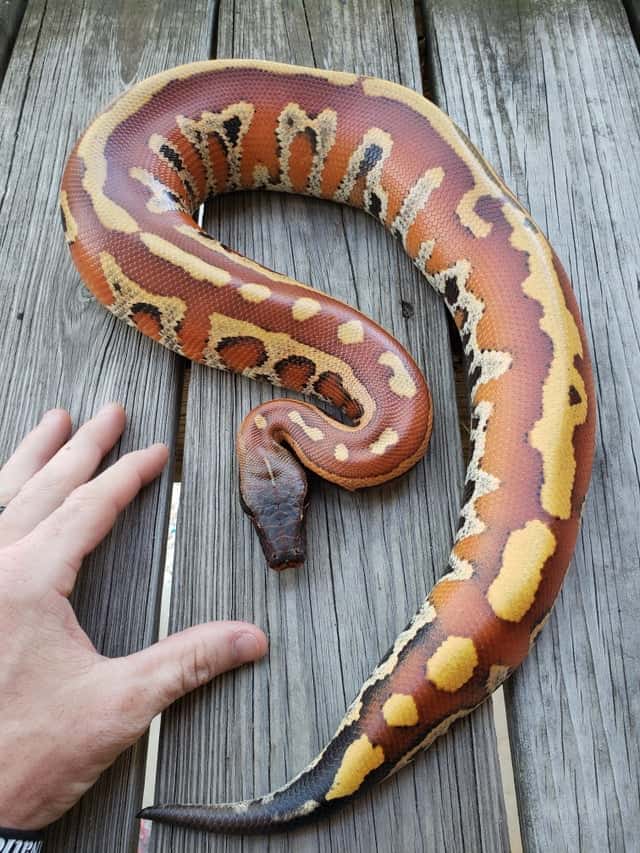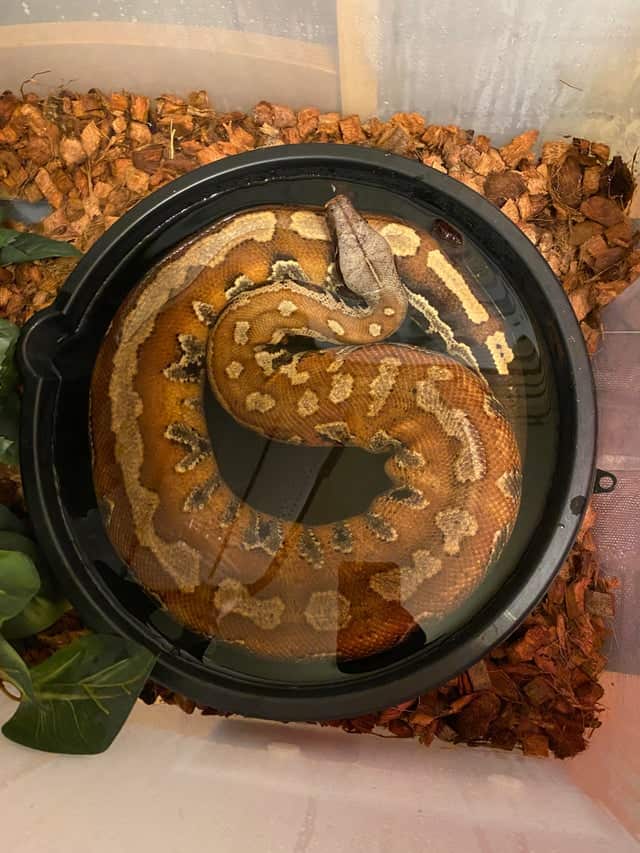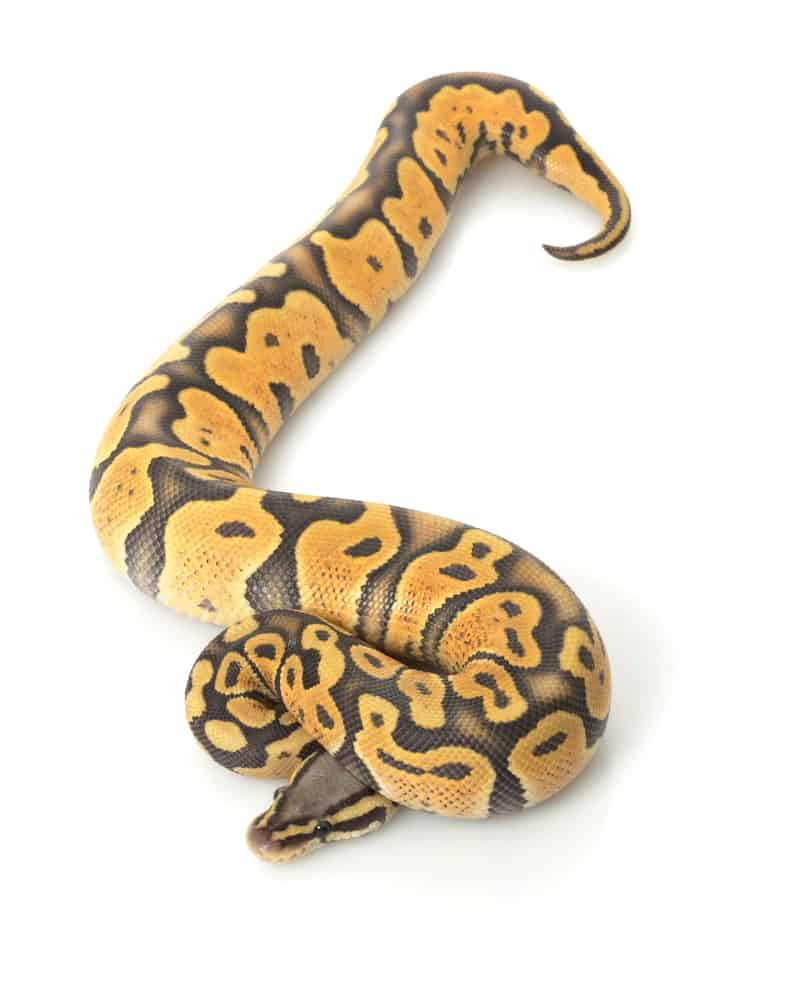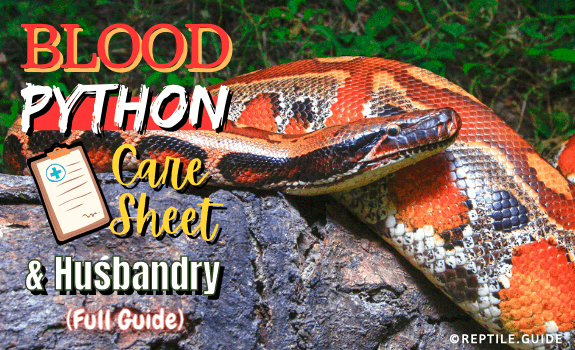Blood pythons (Python brongersmai) are a mid-sized, non-venomous snake species native to Southeast Asia.
Their common name refers to the unique “blood red” coloration that some individuals possess. They’re also known for their short tails and stocky body shape.
Other common names include the red short-tailed python or Brongersma’s short-tailed python.
Blood pythons have a reputation for being aggressive snakes. Most keepers agree that this is poorly justified.
Like any snake species, blood pythons have individual personalities ranging from aggressive to placid.
They are large snakes with a powerful strike. They can deliver a nasty bite if mishandled!
These pythons are also less forgiving in terms of care than other snake species, making them a good fit for snake keepers already experienced with pythons and boas.
In This Article
What You’ll Learn
In this article, you’ll learn:
- Whether a blood python is a good choice for you
- All about blood pythons in the wild, including their conservation
- How to correctly house blood pythons and create a healthy environment
- Common substrates that are well-suited for blood pythons (and others to avoid)
- Common health problems, including symptoms, causes, and methods of prevention
…and much more!
Blood Python Background Information
Blood pythons are native to the Malay Peninsula, Thailand, eastern Sumatra, and other adjacent islands.
Until recently, the blood python had a fierce reputation in the pet trade due to the behavior of wild-caught adults.
Adult pythons were often collected from the wild due to their use in the skin trade.
These adult snakes had not become accustomed to human contact before arriving in the hands of overseas collectors, resulting in high aggression and stress levels.
Unfortunately, this reputation still haunts the blood python, despite the increasing availability of captive-bred hatchlings.
In this section, you’ll learn all about the lifestyle and characteristics of blood pythons in the wild. We’ll also discuss the history of the species and its future in terms of conservation.
Description
Blood pythons are highly distinctive, vibrantly colored pythons. They can reach around six feet in length.
They’re sexually dimorphic, with males being smaller than females.
An adult male blood python typically measures between three and five feet, whereas females can exceed five feet.
They’re extremely stocky, with a short tail relative to other pythons. At first glance, they often appear overweight!
Though not as long as other members of the genus, blood pythons are pretty heavy for their size. Adults can exceed 20 lbs in weight!
As their name suggests, their color can range from a vivid crimson to rusty orange or brown.
It’s this beautiful coloration that first attracts many keepers to this odd-looking species.

Otherwise, their markings are similar to other pythons: a pattern of darker blotches and rough stripes against a contrasting tan background.
Their design becomes darker towards the tail.
Many unusual blood python morphs are now available from captive breeders around the world, including albino and striped varieties.
Lifespan
Blood pythons are long-lived snakes, with an average lifespan of around 25 years.
With excellent husbandry, some individuals have even been known to exceed 30 years!
Habitat and Ecology
The marshes, swamps, and humid forests of Southeast Asia provide prime habitats for the blood python. They’re also found regularly on palm oil plantations.
As primarily terrestrial snakes, they live in the leaf litter of the forest floor.
Blood pythons are incredibly sedentary and can sit still for long periods, waiting for prey. Their diet in the wild consists primarily of rodents and other small mammals.
The Short-Tailed Python Species Complex
Blood pythons (Python brongersmai) are closely related to Borneo (Python breitensteini) and Sumatran (Python curtus) short-tailed pythons.
Blood pythons are the only species known to appear in bright red morphs. Sumatran short-tails are typically dark in color.
Some keepers – incorrectly – refer to these as subspecies or morphs of the blood python.
Until recently, scientists believed the blood and Borneo pythons were subspecies of the short-tailed python. They were deemed individual species in 2000 and 2001, respectively.
Conservation
The blood python is listed as a species of “Least Concern” on the IUCN Red List.
Its geographical range is relatively extensive and mostly intact – not fragmented by human development.
These snakes are becoming more abundant, particularly in Malaysia.
This increase may be due to the expansion of oil palm plantations in the region. Oil palm habitats seem to favor blood pythons, providing plenty of rodents for them to eat.
Despite their apparent success, collectors heavily harvest these snakes for the leather trade. It’s unclear if the current rate of harvest is sustainable.
Buying a Healthy Blood Python
Many of the blood pythons you’ll encounter for sale are what’s known as “captive-hatched”. This often means that they were the result of a wild-caught gravid female python laying eggs in captivity.
You’ll also find excellent quality pythons offered for sale directly from specialist breeders. Captive-bred blood python hatchlings are becoming more common all the time and are much easier to deal with.
When purchasing any snake, it’s vital to consider the history of the animal as well as its overall health.
Captive-hatched (and wild-caught) snakes are likely to have experienced more stress than captive-bred specimens during the international export process.
This early-life stress can lead to long-term health issues and snakes being less amenable to handling.
In addition to the history of the animal, consider its current health status.
Is it active and alert? Unhealthy snakes often appear limp or lifeless.
Is its skin free of wounds or lesions? Blisters and sores could be indicative of an infectious disease that you do not want to introduce to your collection.
Poor body condition (obesity or emaciation) often reflects poor health or husbandry. Avoid snakes that don’t appear well looked-after.
Also, it’s vital to purchase responsibly when buying any live animal.
Blood pythons can live for up to 30 years, so be prepared for a long-term care commitment! Never commit to purchasing an animal if you cannot provide care for its entire lifespan.
The export of wild-caught specimens harms native populations. Consider the ethics of your purchase before bringing a python home.
We recommend that you avoid supporting wild export to preserve these beautiful animals’ status in the wild.
Purchasing directly from a reputable breeder guarantees that your animal was captive-bred. You will also find that breeders are often highly responsive to questions and willing to share expert care advice.
They may also be able to put you in touch with an exotic vet in your area.
Creating the Ideal Blood Python Tank Setup
Blood pythons are shy, sedentary snakes. They do well in remarkably straightforward setups, provided that they are quiet and cozy.
There are some vital considerations that keepers of this species should bear in mind. We’ll outline all of the blood python’s housing needs in the following section.
Enclosure Size and Shape
As a primarily terrestrial species, blood pythons prefer to make use of horizontal space within their environment. Enclosures should be wider than they are tall.
Enclosure size is a hugely important consideration for blood pythons in captivity.
For growing blood pythons, enclosure size will need to be changed several times throughout their lifespan.
Secrecy and security are vital for this species, particularly as hatchlings.
Large, open spaces can cause these snakes to become stressed. These spaces may, in turn, reduce their willingness to feed.
Hatchlings (up to six months old or eight to twelve inches long) require a small enclosure. A ten-gallon tub or similarly sized plastic vivarium is ideal for hatchlings.
Aim for an enclosure with around 60 square inches of floor space.
By around six months of age, juvenile blood pythons will have already outgrown their first enclosure.
Provide juveniles (two to three feet) with around 180 square inches of floor space.
At this point, some keepers opt to move juveniles to their adult enclosure.
Adults do well with a little over 1000 square inches of floor space. A 4-5 ft by 2 ft enclosure is considered ideal.
Reminder: Ensure that any tubs used have a secure lid and adequate ventilation, as well as somewhere to hide.
Types of Enclosures
Blood pythons are secretive animals and prefer a space that provides more privacy.
Opaque-walled vivariums are the best choice for most keepers. They provide an enclosed space and prevent snakes from feeling too vulnerable.
Wooden or plastic options are both acceptable, provided they’re suitable for humid enclosures.
Many breeders opt to house blood pythons in ventilated plastic tubs with an easy-to-replace substrate (such as newspaper), a water bowl, and a hide.
This setup offers advantages, primarily to owners of a large number of animals.
Though it may seem overly simplistic to some, tub setups are easy to clean and maintain.
Blood pythons do well in both types of setups, so choices ultimately boil down to keeper preference.
Like most snakes, blood pythons are excellent escape artists. Secure your snake’s enclosure with a latch or sliding door that cannot be pushed open.
Ideal Temperature Range
The ideal temperature range for blood pythons is around 25.5-28°C (78-82°F).
Keep temperatures towards the lower end of this spectrum overnight to mimic a natural day/night cycle.
For blood pythons, there are two acceptable heating approaches to choose from.
1) Overall ambient temperature – Heating the entire enclosure to a consistent temperature.
2) Hot spot – Creating a “hot spot” by placing a heating pad under one side of the enclosure. This method allows your snake to thermoregulate effectively.
Heating your reptile room is the best way to maintain a comfortable ambient temperature.
Blood python breeders and collectors often prefer this approach, especially if they keep many bloods or short-tails in a single room.
For the more casual keeper – looking only to own one or two blood pythons – the hot spot approach is often more appropriate.
Heat pads are the most effective method of creating a hot spot for terrestrial, non-arboreal snakes.
Ensure that all heat pads are connected to a functioning thermostat to prevent overheating.
Check temperature during daily tank maintenance to help prevent stress and respiratory infections.
Ideal Humidity Level
Blood pythons dwell in moist, tropical environments in the wild. They require a relatively high ambient humidity.
Most keepers agree that around 60-70% humidity is ideal for this species.
If humidity is too high, these snakes can easily develop respiratory conditions such as pneumonia. Respiratory infections are common with blood pythons.
Humidity levels that are too low can cause shedding complications.
Humidity is easier to control when your enclosure meets the following criteria:
- Contains a large water bowl, topped up daily
- Temperature is kept between 25.5 and 28°C (78-82°F)
- Sufficiently ventilated, with a partial screen or air holes
- Appropriately sized for your blood python (not taller or more spacious than necessary)
You may also need to mist your enclosure, particularly if your snake is preparing to shed.
Expert tip: Place your snake’s water bowl toward the middle of the temperature gradient to encourage evaporation. Provided that you top up the bowl daily, this can be a great way to raise the ambient humidity.
Consistently monitoring humidity (and temperature) is vital to the health of blood python. Use a hygrometer to check on your animals daily.
Substrate
For blood pythons, an ideal substrate is something that:
- Is non-toxic to snakes
- Provides an opportunity to burrow
- Is easy to spot-clean or replace regularly
- Helps to maintain ambient humidity (by retaining moisture)
Beyond that, your choice depends mainly on personal preference and budget.
Shredded coconut husk substrate is hygienic, absorbent, and great for maintaining humidity in python enclosures.
A mixture of peat moss and sphagnum moss can create a more natural-looking habitat.
Cypress mulch is another option that looks great and works well with the blood python’s habitat requirements.
Avoid cedar and pine substrates at all costs. These woods contain toxic oils that can kill your snake.
One downside with particulate substrates such as shredded coconut, mulches, or soils is that they can become mixed with snake waste as your snake burrows.
This makes it more difficult to spot clean and can lead to issues with pests (such as fungus gnats).
If you aren’t concerned with the appearance of your enclosure, newspaper, craft paper, or paper towels all make excellent choices for blood pythons.
These options are less costly than reptile bedding and make it easy to see messes as soon as they appear.
Note: If a snake burrows below the substrate and comes into direct contact with the glass above its heat pad, it may receive burns.
Snakes can begin to burn if a surface exceeds 35°C (95°F)
Keepers who opt for lightweight substrates may need to take extra steps to prevent belly burns by adding a heat baffle to the floor of their vivarium.
Check out our ball python substrate guide for a more in-depth discussion of substrate pros and cons.
Decor and Accessories
The ability to hide is essential for blood pythons. Without it, your snake will become stressed quickly.
Create hiding opportunities either by adding a deep substrate layer to facilitate burrowing or by using hide boxes.
Good commercial options include cork bark flats or plastic/ceramic reptile caves.
DIY hide boxes – such as those made from recycled plastic or cardboard boxes – also make acceptable alternatives, provided that they are easy to clean or replace.
Whatever you decide on, ensure that the entrance is large enough that your snake cannot become stuck.
Also, ensure that the hide is large enough to comfortably fit your snake’s entire body inside.
Blood Python Diet and Feeding Guidelines
Blood pythons are typically excellent feeders and easily adjust to a diet of pre-killed or thawed rodents.
Through no fault of their own, they are prone to obesity and feeding aggression.
As a keeper, it’s your responsibility to avoid under or overfeeding your animals and to do so in a way that minimizes the risk of being bitten.
In this section, we’ll explain how to safely feed your blood python, as well as what to feed them and how often.
How to Feed Your Blood Python
A good pair of feeding tongs are essential for blood python keepers.
Adult blood pythons can seriously injure an inexperienced keeper attempting to feed by hand.
As pythons, these snakes rely primarily on their sense of smell and heat-sensitive pits to detect mammalian prey (and to decide where to strike).
When you offer a hungry snake a choice between a room-temperature, thawed rodent, and a warm human hand – they unsurprisingly tend to aim for the latter!
Feeding bites are often far more painful than defensive ones, as the snake is less likely to let go.
Most likely, the snake will sink its teeth into your hand and begin to constrict.
If your snake bites you, never try to yank it off.
Doing so can cause additional damage to your skin and severe damage to the snake itself.
Attempt to gently uncoil the animal. If the snake remains latched on after a minute or so, pour cold water over its head to encourage it to release.
What to Feed Your Blood Python
Blood pythons thrive on a diet of rodents and other small mammals. Frozen/thawed rats make the best food for this species in captivity.
Frozen feeder rodents are readily available from almost any reptile store.
They come in several different size varieties but ultimately will either be rats or mice.
Rats and mice smell slightly different, and snakes often develop a preference for one or the other if fed from birth.
Blood pythons will outgrow mice by the time they are adults, so it’s best to start them off with rats as hatchlings or juveniles.
A hatchling blood python can easily feed on small rats, such as “fuzzies,“ and will need to progress to larger prey over time.
Water
A large, non-tippable water bowl is essential for blood python enclosures.
Not only will this raise the humidity of your enclosure, but it will also allow your snake to soak.
Soaking provides enrichment and also helps with the shedding process.
You’ll need to top up your snake’s water bowl daily.

How Often to Feed Your Blood Python (by Age)
Many keepers overfeed their blood pythons. Though they are large, bloods have a relatively slow metabolism and can last a long time between feeds.
Adult blood pythons need to eat a large rat every other week. You can adjust the size of your python’s meal accordingly if it begins to look under or overweight.
Juveniles and hatchlings require a size-appropriate rodent once per week. This frequency provides them with the extra energy they need to grow and develop.
Blood Python Health Information
One crucial factor to consider with blood pythons is that they’re prone to respiratory infections.
This species also defecates rarely (only around once per month). This frequency needn’t be a cause for concern and is mainly due to their slow metabolism.
Respiratory Infection
As many keepers and online sources will tell you, blood pythons are prone to respiratory infections.
Infections often begin with the mouth (mouth rot) and gradually progress through the upper respiratory tract. This can be fatal if left untreated.
Look for common symptoms such as:
- Lethargy
- Unwillingness to feed
- Mucous discharge from mouth or nostrils
- Wheezing sounds and open-mouthed breathing
Take your python for veterinary assistance immediately if it develops any of these symptoms.
Your snake will require vet-prescribed antibiotics, but should pull through if the disease is caught and treated early.
maintain healthy humidity levels and temperature at all times.
Also, maintain substrate cleanliness by spot cleaning regularly.
Stuck Shed (Dysecdysis)
Your snake will shed its skin regularly and usually in one piece.
Stuck shed – or dysecdysis – (dead skin clinging to the body following the end of a shed cycle) is a common issue faced by all snake species.
It’s especially common for skin fragments to remain around the head, eyes, or tip of the tail.
If left untreated, stuck skin can cut off blood flow to an area of the body. This skin can lead to tissue necrosis and severe injury over time.
Stuck or incomplete sheds usually occur when the ambient humidity is too low for your snake.
Thankfully, this makes it easily preventable by keeping your enclosure’s humidity at 60-70%.
If your snake still experiences issues, try misting your snake’s enclosure a little throughout the shed cycle (usually up to 14 days) or adding a hydration box.
Treatment of a stuck shed involves soaking your snake in a bowl of warm water and gently removing the leftover skin using a pair of tongs.
Never forcibly remove stuck skin, as this can severely injure your snake.
You may need to soak your snake for several hours for this technique to be effective.
If the skin remains after repeated soaking or a large proportion of the skin remains after a shed, take your snake to see a veterinarian.
Handling
Contrary to what many people believe, blood pythons can take well to handling with proper acclimation.
In this section, we’ll provide some valuable tips to help you safely handle your snake.
First of all, remember that blood pythons are advanced-level snakes and most suitable for keepers already experienced with pythons or boas.
Also, remember that snakes are most likely to bite when expecting food or feeling threatened.
Never attempt to handle your snake within 24 hours of feeding.
Wash your hands thoroughly before attempting to handle your snake.
This step will remove any lingering food smells, making it less likely that your snake will mistake you for prey.
Hatchlings are typically feisty and will strike repeatedly if cornered. It takes time and patience for your snake to learn that you are not a threat.
Newly-purchased snakes also require an adjustment period before they will be amenable to handling.
Allow at least a month before attempting to handle new arrivals.
This period allows them to overcome the stress of being moved to a new environment.
Blood pythons can strike rapidly and from almost any angle.
Obey your snake’s warning signs – such as hissing, musking, and defensive posture. Remember that your snake can still strike at any moment, even if it’s not facing you directly.
After your snake has become adjusted to handling, it’s essential to support its body weight at all times!
These snakes are poor climbers, making handling somewhat awkward.
Expert tip: Handling your snake on a flat surface – such as a sanitized bench or table – can make the whole process safer for pet and keeper alike.
Do Blood Pythons Make Good Pets?
Overall, the blood python does well in captivity, making it an excellent pet for experienced boa or python owners.
Bloods also make an excellent choice for boa or python enthusiasts looking to own a larger animal that is relatively safe to handle.
If you’re looking for an active, charismatic animal to observe for hours on end, then these snakes are not the best choice for you!
They also tend to make inferior display species due to their shy and secretive nature.
If you are a beginner snake keeper and you’re looking for a python with similarly striking coloration, you may wish to consider a ball python.
These snakes are smaller, easier to handle, and come in an enormous variety of eyecatching morphs!
You can learn more about their husbandry in our comprehensive ball python care guide.

If it’s specifically a “blood red” snake you’re after, there are many corn snake morphs that might interest you.
The corn snake (or red rat snake) is considered one of the best beginner snake species.
